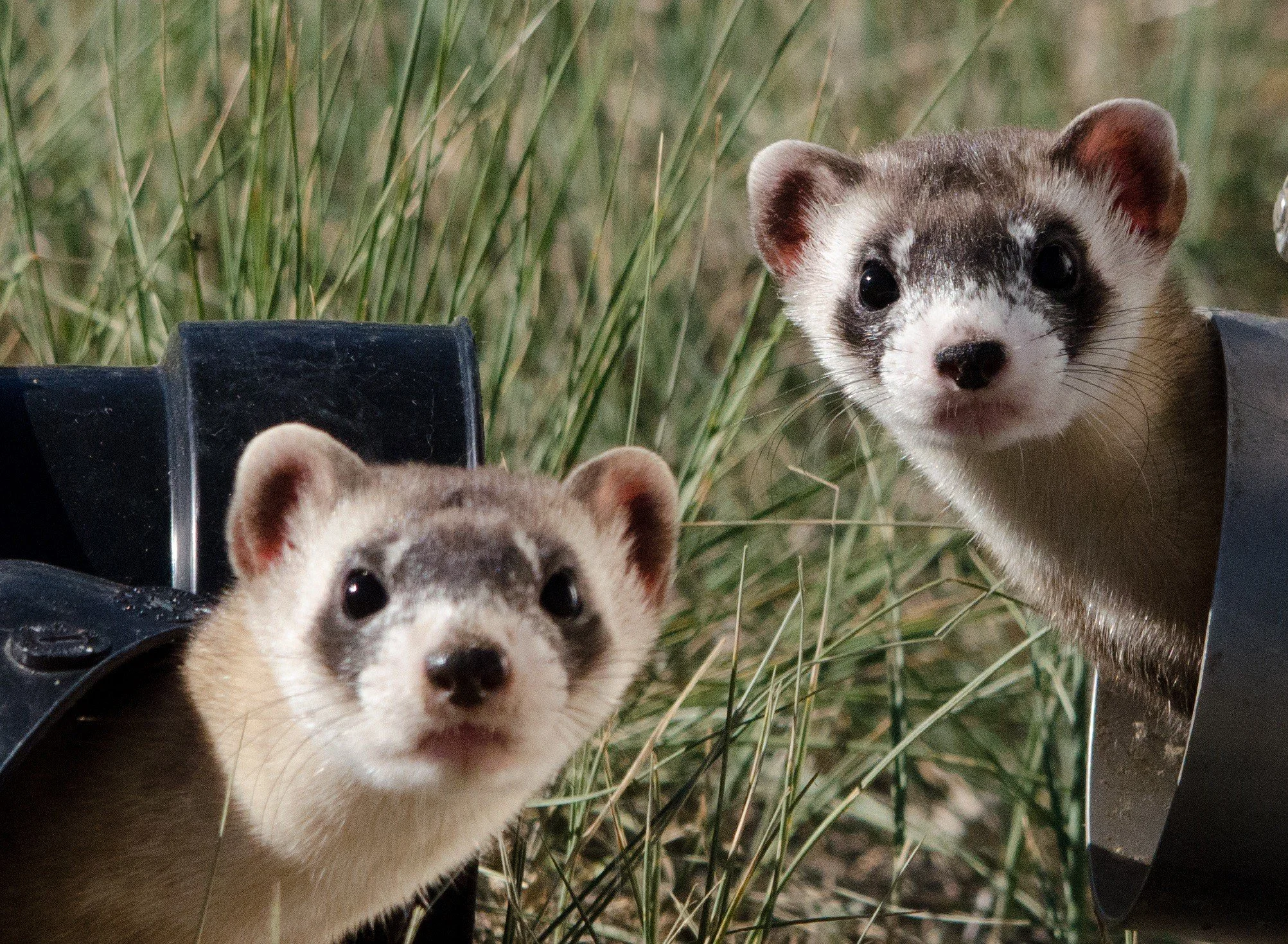📷 Endangered black-footed ferrets | Kimberly Fraser/USFWS
Welcome to the first week of our Refuges For Recovery campaign! As we celebrate the 50th anniversary of the Endangered Species Act (ESA), we embark on a journey deep into the heart of conservation, where remarkable stories inspire hope and action.
Today, we highlight one of the ESA's most iconic success stories: the black-footed ferret (Mustela nigripes). Not too long ago, these elusive creatures teetered on the brink of extinction, with only a handful left in the wild. Today, we're proud to say that the black-footed ferret population is steadily growing, thanks to the unwavering dedication and collaborative efforts of conservationists, scientists, and the National Wildlife Refuge System.
A Second Chance For The Black-Footed Ferret
Black-footed ferret release at Rocky Mountain Arsenal National Wildlife Refuge, Colorado | Gene Reetz & USFWS staff
The black-footed ferret's story is a testament to the resilience of the species and the unwavering commitment of those dedicated to their survival. The journey of this enigmatic creature began long before its rediscovery in 1981.
Before 1964, the black-footed ferret silently slipped into the shadows of obscurity. Native to the vast grasslands of North America, their presence was once widespread. However, as the landscape changed due to human activities, their populations dwindled. During the mid-20th century, people believed these small, masked mammals had become extinct.
In 1964, biologists discovered a small population of black-footed ferrets in South Dakota. However, their survival in the wild was precarious, and sadly, these wild ferrets did not thrive. The ferrets scientists captured in hopes of breeding in captivity faced the same grim fate.
It was not until 1981 that fortune provided a second chance for the black-footed ferret. Biologists and conservationists found another small population, igniting a newfound determination. This momentous rediscovery marked the beginning of an extraordinary collaboration launching the Black-Footed Ferret Recovery Program.
Since 1981, the U.S. Fish and Wildlife Service (USFWS), along with a diverse coalition of federal, state, tribal, and nonprofit partners, united their efforts to safeguard the black-footed ferret. Their mission was clear: prevent the extinction of this species and give them a fighting chance at survival.
Black-footed ferret kits at the National Black-Footed Ferret Conservation Center | USFWS
Today, this dedicated coalition of conservationists captive-breeds black-footed ferrets at five zoos and the USFWS’s National Black-Footed Ferret Conservation Center in Colorado. The goal is to reintroduce these captive-bred ferrets at carefully selected western sites, including Canada and Mexico. After their release, scientists closely monitor them and work tirelessly to reduce threats facing the species.
The journey does not end with their release. Scientists maintain a vigilant watch over these ferrets, monitoring their progress and working tirelessly to mitigate threats facing the species. One such threat is the sylvatic plague, which affects their primary food source, the prairie dog, further challenging their survival. The road ahead is challenging, but the dedication to this remarkable species remains unwavering.
You can learn more by watching the USFWS video here >>
The Critical Role Of National Wildlife Refuges For Imperiled Species
The black-footed ferret, once on the verge of vanishing from the wild, has found refuge in the protected boundaries of our nation's cherished national wildlife refuges. These refuges, meticulously stewarded by the USFWS, serve as essential sanctuaries for countless imperiled species. Within their borders, diverse wildlife species discover the ideal conditions to flourish, recover, and triumph over adversity.
One such refuge, the Rocky Mountain Arsenal National Wildlife Refuge, prominently stands out in this story. Nestled near Denver, Colorado, this urban wildlife haven, conveniently located less than 30 minutes from downtown, embodies hope for the black-footed ferret. Previously believed extinct in the wild, these resilient creatures have been successfully reintroduced within the refuge's flourishing habitat. Here, they have found a sanctuary amidst a tapestry of shortgrass prairies and wetlands, underscoring the invaluable role of the National Wildlife Refuge System in the conservation of threatened and endangered species.
Join Us In The Fight
Black-footed ferret | USFWS
The black-footed ferret's story is one of hope, resilience, and the enduring spirit of conservation. It reminds us that nature has a remarkable capacity to recover when given the chance and that humanity has the power to make a difference in the face of extinction. Although they are still listed as an endangered species under the Endangered Species Act, the black-footed ferrets have made significant progress and their populations are far better than before.
However, these efforts wouldn't be as impactful without you. By supporting the National Wildlife Refuge Association, you directly contribute to the protection and conservation of these precious creatures and the vital habitats they rely upon. Your generous donations serve as the lifeblood of our mission, dedicated to ensuring the National Wildlife Refuge System receives the proper funding and staffing levels it needs to thrive.
As we celebrate the 50th anniversary of the Endangered Species Act, we invite you to join us in this crucial mission. Your support during our Refuges For Recovery campaign helps us celebrate success stories like the black-footed ferret and extend a lifeline to other species in need.




